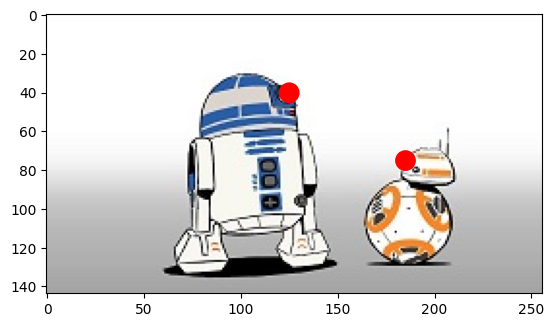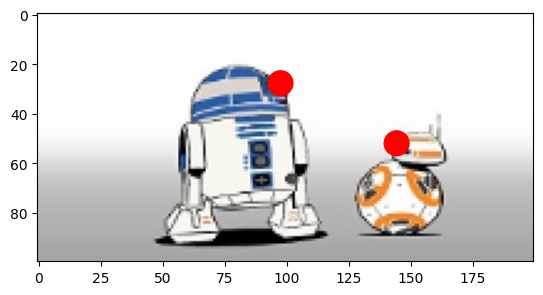Image and Keypoints Augmentations using Kornia and Ivy’s Transpiler#
Introduction#
This tutorial is adapted from Kornia’s official tutorial. We demonstrate how to utilize kornia.augmentation.AugmentationSequential to apply augmentations to images and transform associated keypoints, leveraging Ivy’s Transpiler to run these augmentations in JAX using ivy.transpile.
Original Tutorial Credits#
The original tutorial and code are courtesy of Kornia. This notebook serves as an adapted version, showcasing the integration with Ivy’s Transpiler for JAX compatibility.
Installation and Setup#
[ ]:
%%capture
!pip install kornia
!pip install kornia-rs matplotlib
!pip install flax==0.10.0
!pip install -q ivy
!rm -rf ivy_transpiled_outputs/
[ ]:
import kornia as K
import torch
from matplotlib import pyplot as plt
import ivy
import jax.numpy as jnp
[1]:
import io
import requests
def download_image(url: str, filename: str = "") -> str:
filename = url.split("/")[-1] if len(filename) == 0 else filename
# Download
bytesio = io.BytesIO(requests.get(url).content)
# Save file
with open(filename, "wb") as outfile:
outfile.write(bytesio.getbuffer())
return filename
download_image("https://github.com/kornia/data/raw/main/arturito.jpg")
[1]:
'arturito.jpg'
This line lazily transpiles everything in the kornia api to JAX, and creates a new module for this transpiled version of kornia. Because the transpilation happens lazily, no function or class will be transpiled until it’s actually called.
[3]:
transpiled_kornia = ivy.transpile(K, source='torch', target='jax')
Calling transpiled_kornia.io.load_image will now trigger a transpilation. If this is the 1st time you are transpiling, it will take a few minutes. All subsequent transpilation will reuse the transpiled version and will be much faster.
[4]:
img = transpiled_kornia.io.load_image("arturito.jpg", transpiled_kornia.io.ImageLoadType.RGB32)
img = img[None] # 1xCxHxW / fp32 / [0, 1]
print(img.shape)
(1, 3, 144, 256)
Draw points and show image#
[5]:
coords = jnp.asarray([[[125, 40.0], [185.0, 75.0]]]) # BxNx2 [x,y]
fig, ax = plt.subplots()
ax.add_patch(plt.Circle((coords[0, 0, 0], coords[0, 0, 1]), color="r"))
ax.add_patch(plt.Circle((coords[0, 1, 0], coords[0, 1, 1]), color="r"))
ax.imshow(transpiled_kornia.tensor_to_image(img))
[5]:
<matplotlib.image.AxesImage at 0x7f461dd09270>

Resize points and show#
NOTE: This cell will lazily transpile kornia.augmentation.Resize and kornia.augmentation.AugmentationSequential, which can be computationally intensive and can take a few minutes. Time for a snack break! Grab a refreshment and come back to a freshly compiled augmentation sequence.
[6]:
resize_op = transpiled_kornia.augmentation.AugmentationSequential(
transpiled_kornia.augmentation.Resize((100, 200), antialias=True), data_keys=["input", "keypoints"]
)
print(resize_op.transform_matrix)
img_resize, coords_resize = resize_op(img, coords)
fig, ax = plt.subplots()
ax.add_patch(plt.Circle((coords_resize[0, 0, 0], coords_resize[0, 0, 1]), color="r"))
ax.add_patch(plt.Circle((coords_resize[0, 1, 0], coords_resize[0, 1, 1]), color="r"))
ax.imshow(transpiled_kornia.tensor_to_image(img_resize))
None
/ivy/tracer-transpiler/ivy_transpiled_outputs/jax_outputs/ivy/functional/backends/jax/creation.py:89: UserWarning: Explicitly requested dtype <class 'jax.numpy.int64'> requested in asarray is not available, and will be truncated to dtype int32. To enable more dtypes, set the jax_enable_x64 configuration option or the JAX_ENABLE_X64 shell environment variable. See https://github.com/jax-ml/jax#current-gotchas for more.
ret = jax.numpy.asarray(obj, dtype=dtype)
/ivy/tracer-transpiler/ivy_transpiled_outputs/jax_outputs/ivy/functional/backends/jax/data_type.py:156: UserWarning: Explicitly requested dtype <class 'jax.numpy.int64'> requested in astype is not available, and will be truncated to dtype int32. To enable more dtypes, set the jax_enable_x64 configuration option or the JAX_ENABLE_X64 shell environment variable. See https://github.com/jax-ml/jax#current-gotchas for more.
return jax.numpy.astype(x, dtype)
/ivy/tracer-transpiler/ivy_transpiled_outputs/jax_outputs/ivy/functional/backends/jax/data_type.py:156: UserWarning: Explicitly requested dtype float64 requested in astype is not available, and will be truncated to dtype float32. To enable more dtypes, set the jax_enable_x64 configuration option or the JAX_ENABLE_X64 shell environment variable. See https://github.com/jax-ml/jax#current-gotchas for more.
return jax.numpy.astype(x, dtype)
/ivy/tracer-transpiler/ivy_transpiled_outputs/jax_outputs/ivy/functional/backends/jax/data_type.py:156: UserWarning: Explicitly requested dtype float64 requested in astype is not available, and will be truncated to dtype float32. To enable more dtypes, set the jax_enable_x64 configuration option or the JAX_ENABLE_X64 shell environment variable. See https://github.com/jax-ml/jax#current-gotchas for more.
return jax.numpy.astype(x, dtype)
/ivy/tracer-transpiler/ivy_transpiled_outputs/jax_outputs/ivy/functional/backends/jax/data_type.py:156: UserWarning: Explicitly requested dtype float64 requested in astype is not available, and will be truncated to dtype float32. To enable more dtypes, set the jax_enable_x64 configuration option or the JAX_ENABLE_X64 shell environment variable. See https://github.com/jax-ml/jax#current-gotchas for more.
return jax.numpy.astype(x, dtype)
/ivy/tracer-transpiler/ivy_transpiled_outputs/jax_outputs/ivy/functional/backends/jax/data_type.py:156: UserWarning: Explicitly requested dtype float64 requested in astype is not available, and will be truncated to dtype float32. To enable more dtypes, set the jax_enable_x64 configuration option or the JAX_ENABLE_X64 shell environment variable. See https://github.com/jax-ml/jax#current-gotchas for more.
return jax.numpy.astype(x, dtype)
/ivy/tracer-transpiler/ivy_transpiled_outputs/jax_outputs/ivy/functional/backends/jax/data_type.py:156: UserWarning: Explicitly requested dtype float64 requested in astype is not available, and will be truncated to dtype float32. To enable more dtypes, set the jax_enable_x64 configuration option or the JAX_ENABLE_X64 shell environment variable. See https://github.com/jax-ml/jax#current-gotchas for more.
return jax.numpy.astype(x, dtype)
/ivy/tracer-transpiler/ivy_transpiled_outputs/jax_outputs/ivy/functional/backends/jax/data_type.py:156: UserWarning: Explicitly requested dtype float64 requested in astype is not available, and will be truncated to dtype float32. To enable more dtypes, set the jax_enable_x64 configuration option or the JAX_ENABLE_X64 shell environment variable. See https://github.com/jax-ml/jax#current-gotchas for more.
return jax.numpy.astype(x, dtype)
/ivy/tracer-transpiler/ivy_transpiled_outputs/jax_outputs/ivy/functional/backends/jax/data_type.py:156: UserWarning: Explicitly requested dtype float64 requested in astype is not available, and will be truncated to dtype float32. To enable more dtypes, set the jax_enable_x64 configuration option or the JAX_ENABLE_X64 shell environment variable. See https://github.com/jax-ml/jax#current-gotchas for more.
return jax.numpy.astype(x, dtype)
/ivy/tracer-transpiler/ivy_transpiled_outputs/jax_outputs/ivy/functional/backends/jax/data_type.py:156: UserWarning: Explicitly requested dtype float64 requested in astype is not available, and will be truncated to dtype float32. To enable more dtypes, set the jax_enable_x64 configuration option or the JAX_ENABLE_X64 shell environment variable. See https://github.com/jax-ml/jax#current-gotchas for more.
return jax.numpy.astype(x, dtype)
/ivy/tracer-transpiler/ivy_transpiled_outputs/jax_outputs/ivy/functional/backends/jax/data_type.py:156: UserWarning: Explicitly requested dtype float64 requested in astype is not available, and will be truncated to dtype float32. To enable more dtypes, set the jax_enable_x64 configuration option or the JAX_ENABLE_X64 shell environment variable. See https://github.com/jax-ml/jax#current-gotchas for more.
return jax.numpy.astype(x, dtype)
/ivy/tracer-transpiler/ivy_transpiled_outputs/jax_outputs/ivy/functional/backends/jax/data_type.py:156: UserWarning: Explicitly requested dtype float64 requested in astype is not available, and will be truncated to dtype float32. To enable more dtypes, set the jax_enable_x64 configuration option or the JAX_ENABLE_X64 shell environment variable. See https://github.com/jax-ml/jax#current-gotchas for more.
return jax.numpy.astype(x, dtype)
/ivy/tracer-transpiler/ivy_transpiled_outputs/jax_outputs/ivy/functional/backends/jax/data_type.py:156: UserWarning: Explicitly requested dtype float64 requested in astype is not available, and will be truncated to dtype float32. To enable more dtypes, set the jax_enable_x64 configuration option or the JAX_ENABLE_X64 shell environment variable. See https://github.com/jax-ml/jax#current-gotchas for more.
return jax.numpy.astype(x, dtype)
/ivy/tracer-transpiler/ivy_transpiled_outputs/jax_outputs/ivy/functional/backends/jax/data_type.py:156: UserWarning: Explicitly requested dtype float64 requested in astype is not available, and will be truncated to dtype float32. To enable more dtypes, set the jax_enable_x64 configuration option or the JAX_ENABLE_X64 shell environment variable. See https://github.com/jax-ml/jax#current-gotchas for more.
return jax.numpy.astype(x, dtype)
[6]:
<matplotlib.image.AxesImage at 0x7f45cc3263b0>

Crop image and points#
Now let us define a center crop augmentation sequence to resize the image to a smaller size.
NOTE: This cell will trigger the transpilation of kornia.augmentation.CenterCrop. However, since many dependent objects were already transpiled in previous steps (e.g. AugmentationSequential), the transpilation process should be faster due to caching and reuse of existing transpiled artifacts.
[7]:
crop_op = transpiled_kornia.augmentation.AugmentationSequential(transpiled_kornia.augmentation.CenterCrop((100, 200)), data_keys=["input", "keypoints"])
print(crop_op.transform_matrix)
img_resize, coords_resize = crop_op(img, coords)
fig, ax = plt.subplots()
ax.add_patch(plt.Circle((coords_resize[0, 0, 0], coords_resize[0, 0, 1]), color="r"))
ax.add_patch(plt.Circle((coords_resize[0, 1, 0], coords_resize[0, 1, 1]), color="r"))
ax.imshow(transpiled_kornia.tensor_to_image(img_resize))
None
/ivy/tracer-transpiler/ivy_transpiled_outputs/jax_outputs/ivy/functional/backends/jax/creation.py:89: UserWarning: Explicitly requested dtype <class 'jax.numpy.int64'> requested in asarray is not available, and will be truncated to dtype int32. To enable more dtypes, set the jax_enable_x64 configuration option or the JAX_ENABLE_X64 shell environment variable. See https://github.com/jax-ml/jax#current-gotchas for more.
ret = jax.numpy.asarray(obj, dtype=dtype)
[7]:
<matplotlib.image.AxesImage at 0x7f45cc083580>

Conclusion#
In this tutorial, we demonstrated how to leverage Ivy’s Transpiler to run Kornia’s image and keypoints augmentations in JAX. We showcased the application of various augmentations, including resizing and center cropping.
What’s Next?#
Want to explore more? Dive into our documentation for in-depth guides, tutorials, and API references. Your feedback is invaluable – join our Discord to share your thoughts and suggestions.